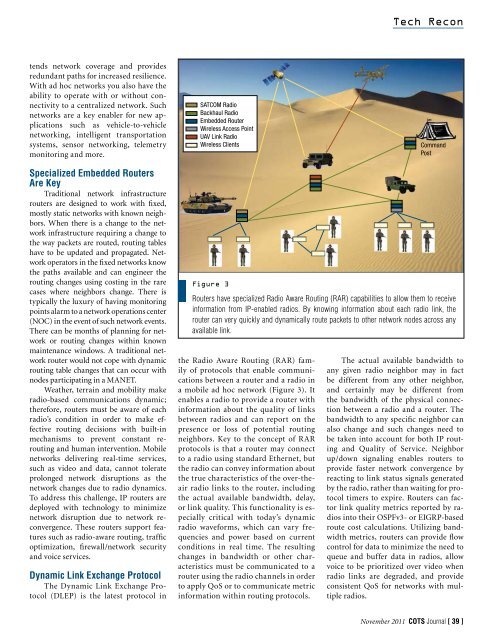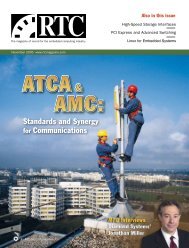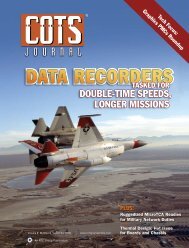Inrush Current Control Technology Boosts Power Converter Reliability
Inrush Current Control Technology Boosts Power Converter Reliability
Inrush Current Control Technology Boosts Power Converter Reliability
You also want an ePaper? Increase the reach of your titles
YUMPU automatically turns print PDFs into web optimized ePapers that Google loves.
tends network coverage and provides<br />
redundant paths for increased resilience.<br />
With ad hoc networks you also have the<br />
ability to operate with or without connectivity<br />
to a centralized network. Such<br />
networks are a key enabler for new applications<br />
such as vehicle-to-vehicle<br />
networking, intelligent transportation<br />
systems, sensor networking, telemetry<br />
monitoring and more.<br />
Specialized Embedded Routers<br />
Are Key<br />
Traditional network infrastructure<br />
routers are designed to work with fixed,<br />
mostly static networks with known neighbors.<br />
When there is a change to the network<br />
infrastructure requiring a change to<br />
the way packets are routed, routing tables<br />
have to be updated and propagated. Network<br />
operators in the fixed networks know<br />
the paths available and can engineer the<br />
routing changes using costing in the rare<br />
cases where neighbors change. There is<br />
typically the luxury of having monitoring<br />
points alarm to a network operations center<br />
(NOC) in the event of such network events.<br />
There can be months of planning for network<br />
or routing changes within known<br />
maintenance windows. A traditional network<br />
router would not cope with dynamic<br />
routing table changes that can occur with<br />
nodes participating in a MANET.<br />
Weather, terrain and mobility make<br />
radio-based communications dynamic;<br />
therefore, routers must be aware of each<br />
radio’s condition in order to make effective<br />
routing decisions with built-in<br />
mechanisms to prevent constant rerouting<br />
and human intervention. Mobile<br />
networks delivering real-time services,<br />
such as video and data, cannot tolerate<br />
prolonged network disruptions as the<br />
network changes due to radio dynamics.<br />
To address this challenge, IP routers are<br />
deployed with technology to minimize<br />
network disruption due to network reconvergence.<br />
These routers support features<br />
such as radio-aware routing, traffic<br />
optimization, firewall/network security<br />
and voice services.<br />
Dynamic Link Exchange Protocol<br />
The Dynamic Link Exchange Protocol<br />
(DLEP) is the latest protocol in<br />
SATCOM Radio<br />
Backhaul Radio<br />
Embedded Router<br />
Wireless Access Point<br />
UAV Link Radio<br />
Wireless Clients<br />
Figure 3<br />
the Radio Aware Routing (RAR) family<br />
of protocols that enable communications<br />
between a router and a radio in<br />
a mobile ad hoc network (Figure 3). It<br />
enables a radio to provide a router with<br />
information about the quality of links<br />
between radios and can report on the<br />
presence or loss of potential routing<br />
neighbors. Key to the concept of RAR<br />
protocols is that a router may connect<br />
to a radio using standard Ethernet, but<br />
the radio can convey information about<br />
the true characteristics of the over-theair<br />
radio links to the router, including<br />
the actual available bandwidth, delay,<br />
or link quality. This functionality is especially<br />
critical with today’s dynamic<br />
radio waveforms, which can vary frequencies<br />
and power based on current<br />
conditions in real time. The resulting<br />
changes in bandwidth or other characteristics<br />
must be communicated to a<br />
router using the radio channels in order<br />
to apply QoS or to communicate metric<br />
information within routing protocols.<br />
Tech Recon<br />
Command<br />
Post<br />
Routers have specialized Radio Aware Routing (RAR) capabilities to allow them to receive<br />
information from IP-enabled radios. By knowing information about each radio link, the<br />
router can very quickly and dynamically route packets to other network nodes across any<br />
available link.<br />
The actual available bandwidth to<br />
any given radio neighbor may in fact<br />
be different from any other neighbor,<br />
and certainly may be different from<br />
the bandwidth of the physical connection<br />
between a radio and a router. The<br />
bandwidth to any specific neighbor can<br />
also change and such changes need to<br />
be taken into account for both IP routing<br />
and Quality of Service. Neighbor<br />
up/down signaling enables routers to<br />
provide faster network convergence by<br />
reacting to link status signals generated<br />
by the radio, rather than waiting for protocol<br />
timers to expire. Routers can factor<br />
link quality metrics reported by radios<br />
into their OSPFv3- or EIGRP-based<br />
route cost calculations. Utilizing bandwidth<br />
metrics, routers can provide flow<br />
control for data to minimize the need to<br />
queue and buffer data in radios, allow<br />
voice to be prioritized over video when<br />
radio links are degraded, and provide<br />
consistent QoS for networks with multiple<br />
radios.<br />
November 2011 COTS Journal [ 39 ]






